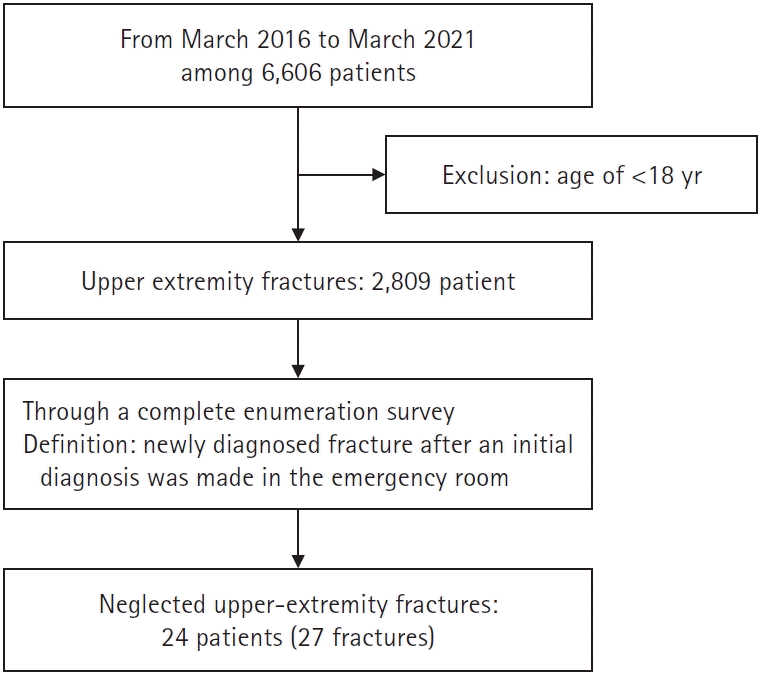1. Park DH, Lee SS, Kim DU, et al. A cause analysis of missed fractures in an emergency medical center. J Korean Soc Traumatol. 2009; 22:37–43.
2. Park HG, Yoo JS, Yi HS. Missed fractures in severely injured patients. J Korean Fract Soc. 2014; 27:113–9.

3. Houshian S, Larsen MS, Holm C. Missed injuries in a level I trauma center. J Trauma. 2002; 52:715–9.

4. Janjua KJ, Sugrue M, Deane SA. Prospective evaluation of early missed injuries and the role of tertiary trauma survey. J Trauma. 1998; 44:1000–7.

5. Vles WJ, Veen EJ, Roukema JA, Meeuwis JD, Leenen LP. Consequences of delayed diagnoses in trauma patients: a prospective study. J Am Coll Surg. 2003; 197:596–602.
6. Buduhan G, McRitchie DI. Missed injuries in patients with multiple trauma. J Trauma. 2000; 49:600–5.

7. Kalemoglu M, Demirbas S, Akin ML, et al. Missed injuries in military patients with major trauma: original study. Mil Med. 2006; 171:598–602.

8. Rizoli SB, Boulanger BR, McLellan BA, Sharkey PW. Injuries missed during initial assessment of blunt trauma patients. Accid Anal Prev. 1994; 26:681–6.

9. Robertson R, Mattox R, Collins T, Parks-Miller C, Eidt J, Cone J. Missed injuries in a rural area trauma center. Am J Surg. 1996; 172:564–8.

10. Brooks A, Holroyd B, Riley B. Missed injury in major trauma patients. Injury. 2004; 35:407–10.

11. Juhl M, Møller-Madsen B, Jensen J. Missed injuries in an orthopaedic department. Injury. 1990; 21:110–2.

12. Born CT, Ross SE, Iannacone WM, Schwab CW, DeLong WG. Delayed identification of skeletal injury in multisystem trauma: the ‘missed’ fracture. J Trauma. 1989; 29:1643–6.
13. Wei CJ, Tsai WC, Tiu CM, Wu HT, Chiou HJ, Chang CY. Systematic analysis of missed extremity fractures in emergency radiology. Acta Radiol. 2006; 47:710–7.

14. Laasonen EM, Kivioja A. Delayed diagnosis of extremity injuries in patients with multiple injuries. J Trauma. 1991; 31:257–60.

15. Pehle B, Kuehne CA, Block J, et al. The significance of delayed diagnosis of lesions in multiply traumatised patients: a study of 1,187 shock room patients. Unfallchirurg. 2006; 109:964–76.
16. Kremli MK. Missed musculoskeletal injuries in a University Hospital in Riyadh: types of missed injuries and responsible factors. Injury. 1996; 27:503–6.

17. Chan RN, Ainscow D, Sikorski JM. Diagnostic failures in the multiple injured. J Trauma. 1980; 20:684–7.

18. Soundappan SV, Holland AJ, Cass DT. Role of an extended tertiary survey in detecting missed injuries in children. J Trauma. 2004; 57:114–8.

19. Pfeifer R, Pape HC. Missed injuries in trauma patients: a literature review. Patient Saf Surg. 2008; 2:20.

20. Enderson BL, Maull KI. Missed injuries: the trauma surgeon’s nemesis. Surg Clin North Am. 1991; 71:399–418.

21. Zamboni C, Yonamine AM, Faria CE, Filho MA, Christian RW, Mercadante MT. Tertiary survey in trauma patients: avoiding neglected injuries. Injury. 2014; 45 Suppl 5:S14–7.

22. Banaste N, Caurier B, Bratan F, Bergerot JF, Thomson V, Millet I. Whole-body CT in patients with multiple traumas: factors leading to missed injury. Radiology. 2018; 289:374–83.

23. Berlin L. Defending the “missed” radiographic diagnosis. AJR Am J Roentgenol. 2001; 176:317–22.

24. Gondek S, Schroeder ME, Sarani B. Assessment and resuscitation in trauma management. Surg Clin North Am. 2017; 97:985–98.

25. Gianola S, Bargeri S, Biffi A, et al. Structured approach with primary and secondary survey for major trauma care: an overview of reviews. World J Emerg Surg. 2023; 18:2.

26. Enderson BL, Reath DB, Meadors J, Dallas W, DeBoo JM, Maull KI. The tertiary trauma survey: a prospective study of missed injury. J Trauma. 1990; 30:666–70.

